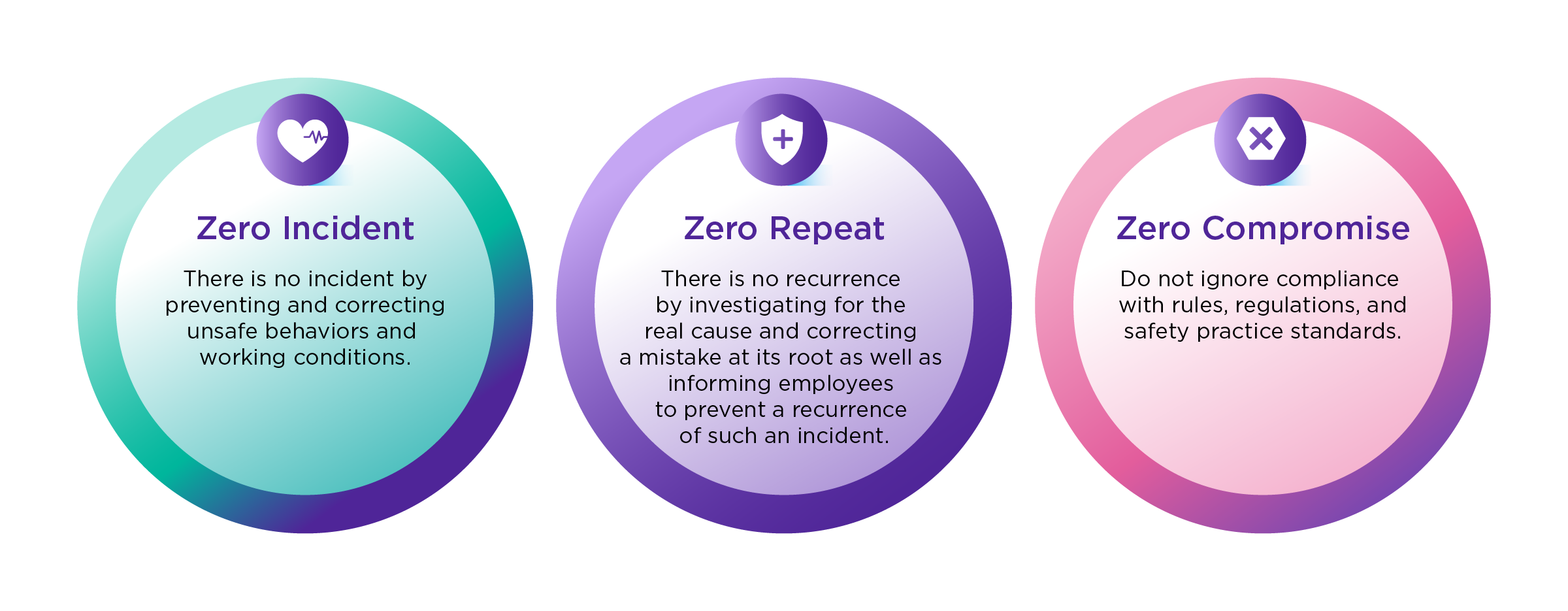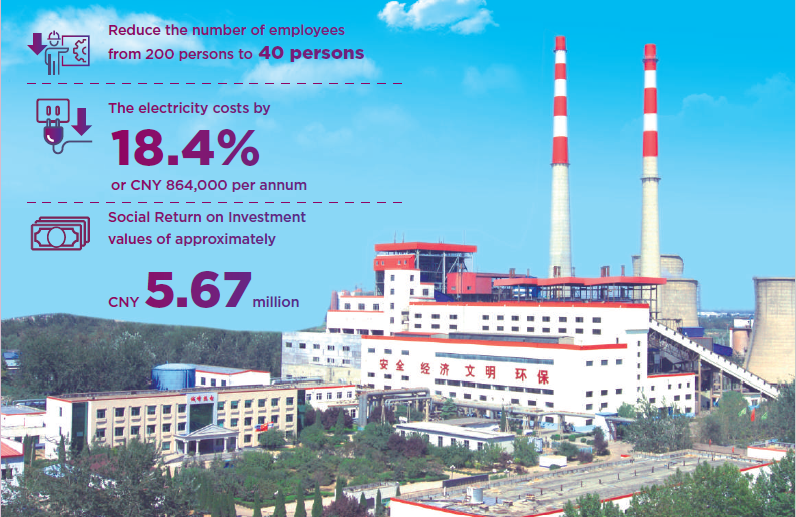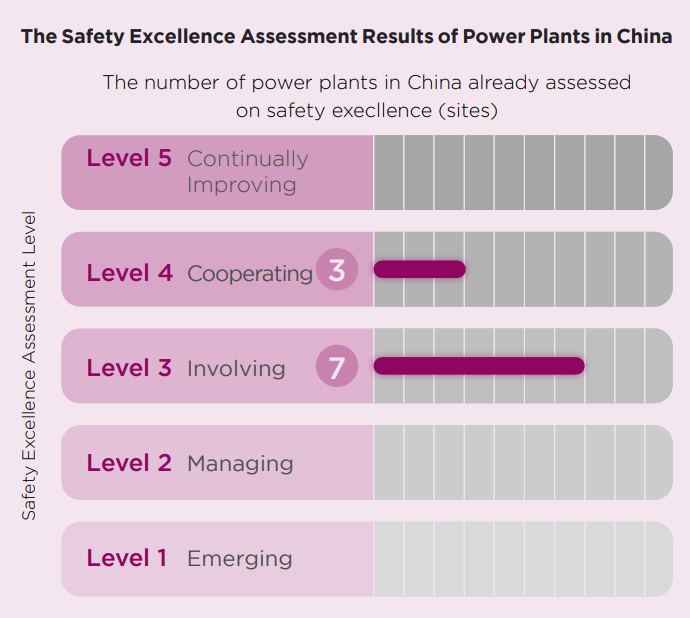Significance
Workplace safety is the utmost target for operations since unsafe working may cause losses of lives and assets, as well as have an impact on the environment and employee’s health. As a result, creating a safety culture to proactively prevent accidents must be carried out and improved regularly for example, arranging a safe working environment, setting up clear preventive measures, monitoring safety performances, fostering knowledge and raising awareness, as well as drawing participations from all employees and involved parties.
A safe workplace environment is counted as the human rights of which employees, contractors and those entering the areas should get sufficiently and equally. In addition, promoting employee participation in expressing their ideas to improve their workplace conditions will finally help in creating their contributions, encouragements and engagements with the organizations.
Management Approach
BPP has focused on cultivating a safety culture within the organization with the ‘3 ZEROs’ target as followings:

To meet the afore-mentioned targets, BPP has conducted its OHS operations in alignment with following safety management approaches.
- Duty and Responsibility on Occupational Health and Safety (OHS) BPP executives, ranging from the highest to operational levels, are committed and responsible for creating work safety. The procedure starts from construction designs to operations, prevention and collection of unsafe working conditions and behaviors. This includes setting up the short- and long-term safety goals, as well as being a role model for safety. Additionally, all employees have duties to create a safe working environment for each other, which is defined as a performance indicator for both senior executives and operational-level employees.
- Compliance with Applicable Laws, Regulations and Safety Operation Standard BPP is rigidly complying with applicable laws and safety best practices. Compliance with applicable laws and safety regulations is regularly examined, while the internationally recognized safety management standards have been implemented at all BPP’s production units.
- Safety Risks Management BPP assesses OHS risks in all work aspects. All of its business units have measures to prevent and mitigate risks related to safety appropriately. For operations having high possibility of severe risks, the risk-mitigation plan must be created in managing risks to the appetite level.
- Cultivating Safety Culture BPP has fostered and paid great values on creating a safety culture among its employees and contractors in all areas where it has operated. It recognizes the safety focused behavior by integrating safety conducts into a corporate culture. At BPP, employees and contractors care for each other, and dare to warn each other if they see unsafe working behaviors.
- Encouraging Employees to Own Adequate Knowledge and Expertise in OHS BPP encourages and educates its employees and contractors about OHS so as to make them have adequate OHS related knowledge able to work safely. It also frequently examines and reviews employee’s OHS understandings.
- Innovation and Safety Technology BPP promotes an adoption of innovations and advanced technologies to further improve its safety operation standards to be better, such as measuring work environment and reporting security risks.
BPP records its safety statistics, covering all workers who are in the scope of control work and control workplace. Those workers are employees, contractors, and persons whom are permitted to enter the operational areas. For operators who are not in the scope of control work or control workplace, BPP will note such accidents, but will not include them in the accident statistic calculation.
Performance
- Zero LTIFR.
- Zero fatality case.
Key Activities and Projects
Activities to promote working safety
BPP organized the work-safety promotion activities, for example:
- Evaluating the level of work safety culture.
- Organizing training and testing safety, environment, safety rules and risks in the areas prior to starting to work, including rigorously reviewing such conduct and rules at a defined time.
- Promoting workplace safety and inspecting operating areas carried out by top management continuously.
- Arranging work safety inspection executed by employees, supervisors, and safety officers during operations.
- Regularly measuring working environment to ensure safety and reporting the results for improvement.
- Setting up the safety improvement committees for offices and power plants.
- To raise safety awareness, communication through various activities was conducted for involved parties, such as organizing a safety day activity, safety promotional emails, games, posters, etc.
- Conducting the emergency simulation exercises continuously and using the exercise results for improvement.
- Organizing safety day activities to communicate safety goals and raise awareness among employees, partners, and contractors.
- Motivating employees to work safely via incentives, such as special rewards for persons who have outstanding safety operations, and celebrations on common achievements, etc.
Employee’s Health Promotion
BPP has provided the health promotions for its employees such as:
- Arranging the annual health check for employees, including physical fitness measurements according to risks arising from the nature of work.
- Measuring work environment in both offices and production units and enhancing working conditions continuously to meet the standards.
- Providing the health insurance for treatments and seeking cooperation to get the provision of vaccines for employees, such as influenza vaccines, and the COVID-19 vaccines.
- Fostering employees to exercise and maintain good health, such as setting up sports clubs, providing health-related knowledge, including arranging an individual exercise trainer for interested staff etc.
- Organizing sports competitions between employees and contractors.
- Initiating a psychological consultation project called “iSTRONG” for employees, allowing them to consult with the external psychological service provider regarding mental matters to reduce stresses from personal life and work. All data consulted will be kept confidentially.
- Online doctor visit project: The project accommodates employees to meet the online doctor via “Health at Work” application. Through this platform, employees can make an appointment and have a preliminary check with the doctor online. Then, the doctor will prescribe the medicines and deliver them to that staff.
- Nursing room and first aids services: The services are provided by registered nurses who can diagnose basic illnesses, prescribe medicines, dress wounds, and provide health advices.
- The “Flexible Benefit” project was created to support an annual budget of THB 12,000 for employees to use in various benefits, inclusion of health, such as expenses for additional medical treatments, sports club membership fees, and devices to facilitate ergonomic working from home, etc.
Smart Inspection and Control System for Heat Exchange Station at Zhengding CHP Plant
Located in Shijiazhuang City, Zhengding County, Hebei Province, People’s Republic of China, Zhengding CHP Plant has a total installed capacity of 139 MWs and produces approximately 10 million Gigajoules (GJ) of heat per year, contributed for users in Zhengding County where around 58,000 residents and more than 180 of the industrial sector, trades and others are living. It is the only power plant producing heat supplied for a centralized heating system in the area, which is essential to residents during winter when the average outdoor temperatures are around 0.3 Celsius.
Zhengding Power Plant has tried to stabilize its heat transmissions and improve the safety by installing equipment and establishing a real-time remoted monitoring system applied to the heat exchange station in order to replace staff visits to the station area, reducing risks and operating times from entering the station zone. More importantly, it has made it possible to quickly detect abnormalities so that they can be corrected immediately, including increasing the power plant’s stability of heat supplies.
The installation of intelligent thermal inspection and control equipment includes:
- Remotely inspecting via video cameras
- Remotely controlling and adjusting the water pump’s recirculation frequencies.
- Remotely controlling and adjusting the steam and hot water flows intensity in the heat exchanger station.
- Employing the information collection system related to pressures and temperatures from various devices in the system such as water pumps, pressure regulator valves, water tanks, etc.
This project implementation has enabled Zhengding CHP Plant to reduce the number of employees inspecting the heat exchanger station from 200 persons to 40 persons, reducing the employee safety risks derived from being exposed to noises and heats and the electricity costs by 18.4%, or CNY 864,000 per annum. When assessing this project’s safety with the Social Return on Investment (SROI), the project has generated values of approximately CNY 5.67 million.

In addition, Zhengding CHP Plant has also upgraded its heating equipment to accommodate thermal generations in accordance with the growing populations in Zhengding County. The plant has also improved its equipment inspections, including developing and exercising the emergency plans. As a result, the plant has been certified by the ISO 45001 Occupational Health and Safety Management System continuously. This has made the power plant to operate stably and safely. There were no working accidents while the availability factor was maintained at a high level of 94.04%. More importantly, the power plant was bestowed the Advanced Unit of Central Heating award from the government sector.
Double Control Application Project for Safe Maintenance at Luannan CHP Plant
Typically, a power plant needs to be planned for maintenance so that the machines can continue operating. The maintenance planning is conducted by the maintenance department, which will proceed the documentations specifying work details, persons working in the area, operational periods and risk assessments to the production department to consider and cut off some working systems so as for safe operations of the maintenance department.
However, there are too many of such documents, which must be sent to different departments for inspections, such as the production and safety units, etc. This has resulted in document losses during operations. Additionally, these documents must be used together by many parties, making it inconvenient and difficult to access risk details of each maintenance. Or if the document is lost, it will not be able to trace back.
Luannan CHP Plant, therefore, has developed the Double Control application to replace all documental operations. In the form of digital, the Double Control application allows relevant parties to create documents requested for approval, giving approval and checking the data simultaneously. It also prevents document losses, making maintenance operations go smoothly while operators stay safe from working. Around 50% of time was also saved. When assessing this project result relating to safety with the Social Return on Investment (SROI) tool, the value of about CNY 104,800 was estimated from this project. The value was gauged from time-saving, enhancing employee’s knowledge, keeping documents for legal retrospection and securities arisen from using this application This was exclusive of the value from project expansion to other BPP’s power plants.
In the past year, Luannan CHP Plant had no major working accidents and has consistently accredited by the Occupational Health and Safety Management System (ISO 45001). Moreover, the plant was selected as the outstanding occupational health enterprises. It was awarded as the outstanding prefectural workers’ vanguard from the government sector as well.
Using digital technology to assure safety for activities having risks
Activities having risks involved with production and maintenance, such as inspecting the areas with high-voltage operations and the starting/stopping processes to operate boilers and steam turbines in the power plants, etc., are the safety risks. As a result, strict prevention is required since it may cause a high impact on the operators and BPP’s operations.
In order to ensure that operations in the areas with risks are carried out correctly and safely, the three combined heat and power (CHP) plants in China, namely Luannan, Zhengding and Zouping power plants, have used digital technology to develop equipment and operational monitoring systems, including:
- Smart Helmet is a safety hard hat equipped with a camera allowing the operator to monitor and assist workers remotely. Controllers can directly communicate with operators through the smart helmet. They can immediately alert the operators if any unsafe situation occurs, or when the operators do not follow the operating procedures. In 2024, this equipment can detect and correct 144 unsafe operations.
- Removable Camera Monitoring System: This system is a live broadcast camera recording and inspecting operator’s works so as to ensure that they operate in accordance with the operating and safety procedures. Supervisors and safety experts can monitor the performance of employees and contractors at all times through this device. In 2024, the surveillance systems with portable cameras were able to inspect 161 operations, detecting and correcting 22 operations with safety risks.
Applying the digital technology to improve the power plants’ safety is a proactive operation to achieve the “Zero Danger” goal through surveillance and creating a safe and efficient working environment. As a result, all 3 CHP plants were able to continue operating safely in 2024. There were no serious work accidents. Moreover, the fatality rate and the lost time injury frequency rate of employees and contractors was zero.
Safety Excellence Assessment
Since 2018, BPP has continuously evaluated the excellence level of its safety culture, by using a survey based upon the Safety Maturity Level of the United Kingdom Health and Safety Executive (UK HSE) model, which divides a safety culture into five (5) levels:
- Level 1: Emerging
- Level 2: Managing
- Level 3: Involving
- Level 4: Cooperating
- Level 5: Continually Improving
The safety excellence assessment is part of BPP’s safety culture cultivation by using the safety awareness survey results in combination with an assessment of the environment and operations in the area to create a plan for continuous safety improvement.
The safety excellence assessments are alternately held every year when each power plant will be evaluated at least every three year.
In 2024, three solar power plants in China, namely Jinshan, Huineng and Hui’en solar power plants were examined the safety excellence, receiving the 3rd safety excellence level (Involving).

At present, all power plants in China have been assessed, including the 3 CHP plants and seven 7 solar power plants. Currently, the 3 CHP plants have obtained the 4th safety excellence level (Cooperating), while 7 solar power plants have got the 3rd level (Involving) The assessment result of each area has been used to create operational development plans for safety, totaling 12 projects.
Document Download
Occupational Health and Safety Policy




